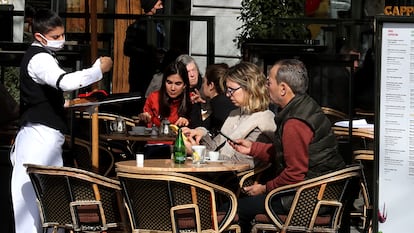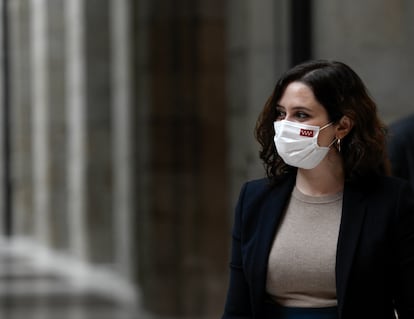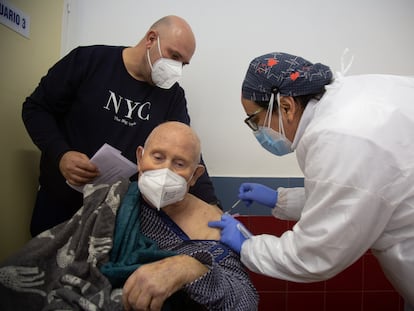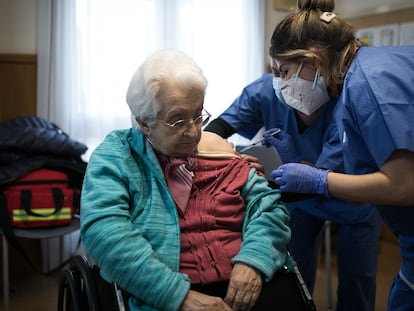Madrid: an island in a sea of coronavirus restrictions
While many major European cities are implementing strict measures, the Spanish capital has a relaxed approach despite warnings from experts about the risks when infection rates remain high


Compared to other major European capitals, Madrid is swimming against the tide with regard to its Covid-19 strategy. Although most of Europe’s main cities are imposing heavy restrictions on both mobility and social activities in a bid to curb the spread of the coronavirus, the Spanish capital is opting for relaxing restrictions despite a 14-day incidence rate of 625 cases per 100,000 inhabitants.
In fact, while Lisbon, London, Paris, Rome, Berlin, Athens and Brussels remain in partial lockdown, Madrid plans to put the curfew and closing times in the hospitality sector back an hour. The Swedish capital, Stockholm, which took a controversial early approach to fighting the virus by trusting to individual responsibility, is one of the few big European cities to take a similar line. But experts warn of the risks of relaxing restrictions when transmission remains high.
“It is a crime to have everything closed in Catalonia, with the good weather you have,” stated Madrid’s regional premier, Isabel Díaz Ayuso, during a visit to Barcelona on January 30. Despite having a much higher rate of infection than Catalonia –at that time, it amounted to 993 versus 564 cases per 100,000 inhabitants – Madrid authorities have consistently opted for less severe measures, deciding against closing bars or limiting any movement in or out of the city. In fact, while most of the major European capitals have closed stores and had their bars and restaurants shut for weeks, Madrid has already announced that, infection rates permitting, it will change the 10pm curfew to 11pm and extend the hospitality sector’s opening hours to coincide.

“There are no epidemiological criteria to justify Madrid’s measures,” says Daniel López-Acuña, a former director of emergencies at the World Health Organization (WHO). “It is political stubbornness aimed at polarizing against the measures of the central government. None of the epidemiological parameters indicate that measures should be eased in Madrid.”
As well as having an infection rate well above the Health Ministry’s threshold for extreme risk, which stands at 250 per 100,000, Madrid also suffers from intense hospital pressure with half of its intensive care beds occupied by Covid-19 patients (716). The rate of diagnostic tests coming back positive, which should be below 5%, is bordering on 20%. “This means that there is significant community transmission and many undetected asymptomatic patients,” says López-Acuña.
But despite its epidemiological situation, Madrid is determined to loosen measures further. In fact, last week it increased the maximum number of people allowed to sit at outdoor dining tables from four to six.
This contrasts sharply with the strategy of seven other major European capitals, which are taking a more conservative approach. In Lisbon, where the incidence rate has rocketed to 2,123 cases per 100,000 inhabitants, restaurants, stores and cultural venues have been completely closed, with restaurants doing only home deliveries and takeaway. But cities with infection rates far lower than those of Madrid are also keeping a lid on economic activities that involve social interaction: restaurants are closed, for example, in Berlin where the infection rate is approximately 120 cases per 100,000, London (382 cases per 100,000 in the UK), Athens (111 per 100,000 in Greece), Paris (237) and Brussels (250). In Rome (251 cases per 100,000 in the Lazio region), bars and restaurants close at 6pm.
I sense that Madrid is copying the Swedish strategy, but in a crude fashionSalvador Peiró, Foundation for the Promotion of Health and Biomedical Research
Cultural venues have also been shut down in many of Europe’s major capitals. Unlike Madrid, where museums, cinemas and theaters can open until 10pm, everything is closed in Paris, Berlin, Athens and London – which has one of the strictest lockdowns. In Rome, museums and archaeological landmarks, such as the Colosseum, are open from Monday to Friday, but cinemas and theaters are closed. In Brussels, only museums are open.
In terms of retail activity, there is even greater disparity between European cities, but Madrid remains one of the most relaxed. In the Spanish capital, stores are open until 9pm, although there are capacity limitations in department stores and small shops. In cities where restrictions are tighter, such as London, Berlin, Lisbon and Athens, only stores selling essential goods, such as supermarkets, are open. In Brussels, stores operate until 8pm and, in Paris and Rome, there are restrictions in shopping centers.
Another controversial aspect of Madrid’s strategy is its approach to mobility restrictions. To start with, it is insisting on putting the curfew hour back to 11pm when other major European cities have stricter limits on nighttime mobility: 10pm in Rome, 9pm in Athens, 6pm in Paris. In January, Portugal imposed a 1pm curfew on weekends in infection hotspots.
Moreover, while other European cities have opted for very strict perimetral or even home lockdowns (such as Lisbon, Athens and London), Madrid has limited its confinement strategy to basic healthcare zones, areas that do not coincide with neighborhoods or districts but are instead defined by the health centers they contain. As of Monday, there will be restrictions for entering and leaving 55 of these zones, as well as 14 municipalities in the Madrid region. “It is useless to isolate areas when the whole region is equally bad,” says Salvador Peiró, an epidemiologist at the Foundation for the Promotion of Health and Biomedical Research.
Experts explained from the outset that this kind of restriction fell short on two counts: an area to be confined must be a geographical space that is recognizable to the population; and, when an area is confined, it should be because it has a visibly higher rate of infection than the surrounding area. Madrid’s strategy meets neither of these criteria. Moreover, the rules include so many exceptions, such as going to the doctor, to school, to work or to carry out administrative procedures, that these limits have turned out to be ineffectual.
The Swedish model

With a 14-day incidence rate of 388 per 100,000 inhabitants, Sweden has also opted for a less strict approach, but its reliance on recommendations and individual responsibility during the first wave of the pandemic proved controversial. When the number of positive cases soared, Sweden did a rethink and imposed tougher restrictions from January. However, Stockholm is still way out of sync with other major European capitals: there are recommendations to limit mobility, but no restrictions; stores and restaurants are open, and cultural venues have capacity limitations that have led major theaters, operas and cinemas to pull down their shutters of their own free will.
“I sense that Madrid is copying the Swedish strategy, but in a crude fashion,” says Peiró. “I think they are counting on the fact that they have a certain basic immunity [due to the high number of positive cases during the first wave], and they are lucky that the people themselves appear to realize they cannot trust the government’s measures and have adopted safer behavior.”
But epidemiologists warn that the lack of restrictions will take its toll. “Madrid thinks that by rushing to open up, it will stabilize the epidemiological and economic situation sooner,” says López-Acuña. “This is not the case. What it does is to open the floodgates to spikes and keep the curve at chronically high levels, which will lead to more closures.”
Experts urge caution when it comes to deescalation. “We are all dealing with an unknown – the expansion of the British strain of the virus, which is more contagious,” says Peiró, explaining that rapid deescalation can lead to a rebound scenario. “We should be on the alert and I think this threat is behind the restrictions being maintained in Europe. If the British variant takes hold here very quickly, it’s bad news for us. We need to gain time to vaccinate, let the health system breathe and resume the care of non-Covid-19 patients.”
With reporting by I. Valdés, R. de Miguel, G. Abril, M. Bassets, C. Ballesteros, L. Pacho, E. G. Sevillano and D. Castaño.
English version by Heather Galloway.
Tu suscripción se está usando en otro dispositivo
¿Quieres añadir otro usuario a tu suscripción?
Si continúas leyendo en este dispositivo, no se podrá leer en el otro.
FlechaTu suscripción se está usando en otro dispositivo y solo puedes acceder a EL PAÍS desde un dispositivo a la vez.
Si quieres compartir tu cuenta, cambia tu suscripción a la modalidad Premium, así podrás añadir otro usuario. Cada uno accederá con su propia cuenta de email, lo que os permitirá personalizar vuestra experiencia en EL PAÍS.
¿Tienes una suscripción de empresa? Accede aquí para contratar más cuentas.
En el caso de no saber quién está usando tu cuenta, te recomendamos cambiar tu contraseña aquí.
Si decides continuar compartiendo tu cuenta, este mensaje se mostrará en tu dispositivo y en el de la otra persona que está usando tu cuenta de forma indefinida, afectando a tu experiencia de lectura. Puedes consultar aquí los términos y condiciones de la suscripción digital.
More information
Últimas noticias
Welcome to the post-religion era: The idea of Christianity as the absolute truth has become obsolete
‘I thought you would like it’: The risky sexual practice popularized by TV shows and TikTok
The digitalization of tourism: ‘They promise experiences and gave us the worst possible one’
Mexican peso defies uncertainty with forecasts of a new period of stability in 2026
Most viewed
- Sinaloa Cartel war is taking its toll on Los Chapitos
- Oona Chaplin: ‘I told James Cameron that I was living in a treehouse and starting a permaculture project with a friend’
- Reinhard Genzel, Nobel laureate in physics: ‘One-minute videos will never give you the truth’
- Why the price of coffee has skyrocketed: from Brazilian plantations to specialty coffee houses
- Silver prices are going crazy: This is what’s fueling the rally










































